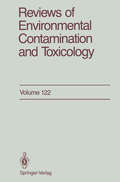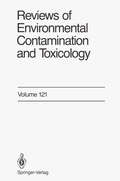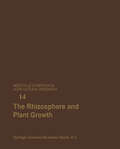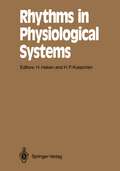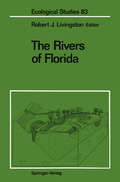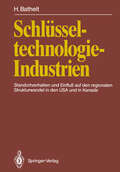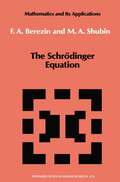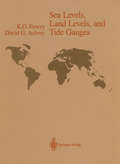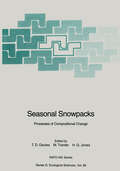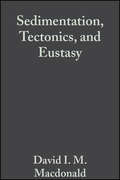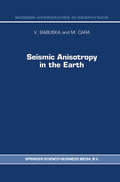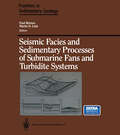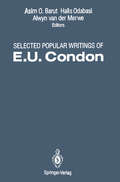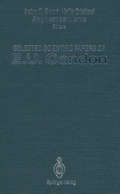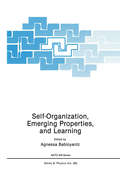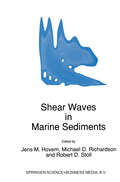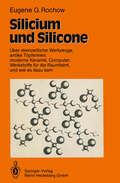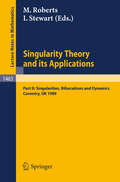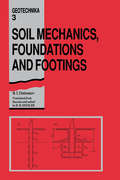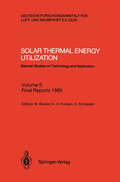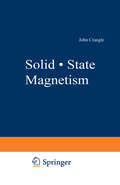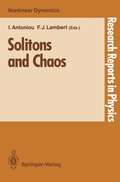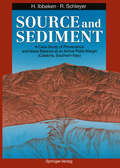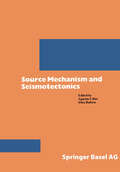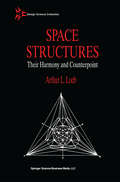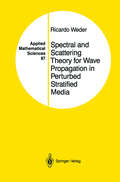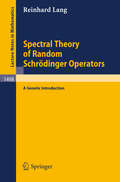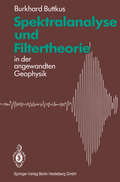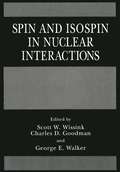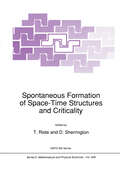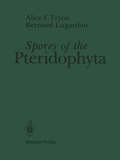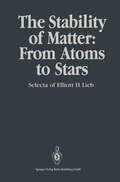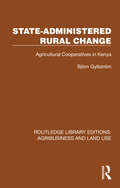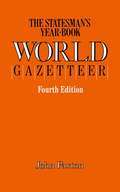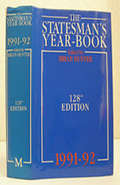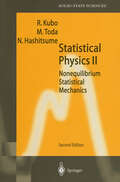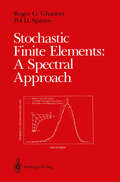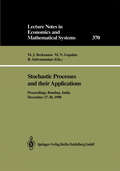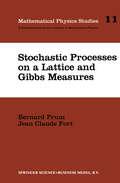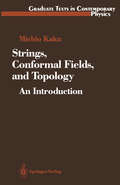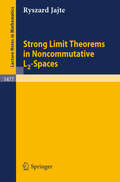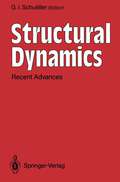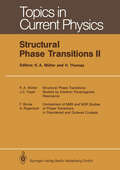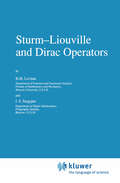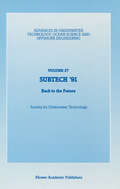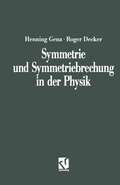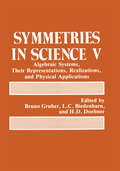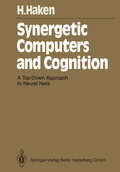- Table View
- List View
Reviews of Environmental Contamination and Toxicology: Continuation of Residue Reviews (Reviews of Environmental Contamination and Toxicology #122)
by George W. WareReviews of Environmental Contamination and Toxicology publishes authoritative reviews on the occurrence, effects, and fate of pesticide residues and other environmental contaminants. It will keep you informed of the latest significant issues by providing in-depth information in the areas of analytical chemistry, agricultural microbiology, biochemistry, human and veterinary medicine, toxicology, and food technology.
Reviews of Environmental Contamination and Toxicology: Continuation of Residue Reviews (Reviews of Environmental Contamination and Toxicology #121)
by George W. WareReviews of Environmental Contamination and Toxicology publishes authoritative reviews on the occurrence, effects, and fate of pesticide residues and other environmental contaminants. It will keep you informed of the latest significant issues by providing in-depth information in the areas of analytical chemistry, agricultural microbiology, biochemistry, human and veterinary medicine, toxicology, and food technology.
The Rhizosphere and Plant Growth: Papers presented at a Symposium held May 8–11, 1989, at the Beltsville Agricultural Research Center (BARC), Beltsville, Maryland (Beltsville Symposia in Agricultural Research #14)
by Donald L. Keister Perry B. CreganPapers Presented at a Symposium held May 8--11, 1989, at the Beltsville Agricultural Research Center (BARC), Beltsville, Maryland, U.S.A.
Rhythms in Physiological Systems: Proceedings of the International Symposium at Schloß Elmau, Bavaria, October 22–25, 1990 (Springer Series in Synergetics #55)
by Hermann Haken Hans P. KoepchenRhythms are a basic phenomenon in all physiological systems. They cover an enormous range of frequencies with periods from the order of milliseconds up to some years. They are described by many disciplines and are investigated usually in the context of the physiology of the respective function or organ. The importance given to the research on rhythmicity is quite different in different systems. In some cases where the functional significance is obvious rhythms are at the center of interest, as in the case of respiration or locomotion. In other fields they are considered more or less as interesting epiphenomena or at best as indicators without essential functional significance, as in the case of cardiovascular or EEG rhythms. Recently the study of physiological rhythms has attracted growing interest in several fields, especially with respect to rhythm research in humans and its rapidly spreading applications in basic behavioral research, and as a diagnostic tool in clinical medicine. This development was favored by two methodological and conceptual ad vances: on the one hand, the availability of non-invasive methods of continu ous recording of physiological parameters and their computer-assisted evaluation, and on the other, the rapid development of theoretical analyses, for example, the understanding of dynamic systems, the generation of coordinated macroscopic pro cesses in systems comprising many single elements, and the mathematical tools for treating nonlinear oscillators and their mutual coupling.
The Rivers of Florida (Ecological Studies #83)
by L. Ager D.G., Jr. Bass A. F. Clewell C. L. DeMort L. K. Dixon J. H. Epler E. D. Estevez E. A. Fernald M. S. Flannery T. H. Fraser K. M. Hammett F. Jr. Jordan W. R. Karsteter C. C Koenig J. A Kushlan S. F. Leitman B. F. McPherson C. Mesing A.K.S.K. Prasad G. L. RayThis book addresses basic questions concerning the ecological relationships and current conditions of the major river systems in Florida . . There have been relatively few comprehensive studies made of the rivers of Florida. There is, to be sure, voluminous information that addresses various aspects of riverine ecology. However, little such information has been collected in a way that allows even a preliminary understanding of the driving forces that determine how the diverse freshwater and associated brackish systems function. This lack of useful data is the product of a fundamental ignorance concerning the scale of endeavor, both spatially and temporally, that is needed if we are to understand and, parenthetically, manage the major drainage systems of this area of the country (Livingston, 1987). Research used to address management problems should entail a continuous series of interrelated studies, descriptive and experimental, that answer the immediate (and often less important) questions that are asked on a day-to-day basis. The research should also be designed to answer questions that have not yet been asked. In other words, ecosystem research should be organized on an appropriate scale so that system-wide processes are understood and pr
Schlüsseltechnologie-Industrien: Standortverhalten und Einfluß auf den regionalen Strukturwandel in den USA und in Kanada
by Harald BatheltSea Levels, Land Levels, and Tide Gauges
by K.O. Emery David G. AubreyChanges in sea level caused by global warming can be disastrous to modern civilization. Therefore, it is important to use accurate and reliable methods to monitor any change. During this century, and, in particular, the last three decades, tide-gauge records have been used to show these changes related to the world's oceans. Aubrey and Emery suggest, however, that tidal gauges should not be used unquestioningly as a benchmark for measuring eustatic sea-level changes. Tectonism, subsidence, ocean current variability, and human activity can, and do, affect the accuracy of these records. Understanding the reasons for changes in land and sea levels is essential for the proper development of coastal regions. The results of this study provide guiding data for scientific, engineering, and policy solutions to coastal flooding. Determining the true causes of relative subsidence, and how to use geological and oceanological controls, will allow us to exist within our natural environment, rather than force nature to conform to our legal and temporary 'remedies.'
Seasonal Snowpacks: Processes of Compositional Change (Nato ASI Subseries G: #28)
by Trevor D. Davies Martyn Tranter H. Gerald JonesSeasonal Snowpacks examines the processes which control the chemistry of seasonal snowcover and provides detailed information on the biogeographical distribution of snow (e.g. urban, alpine snowpacks), snow composition (e.g. micropollutants, stable isotopes) or the physical and biological processes which influence the chemical changes in snow (e.g. wind, microbiological activity). The fluxes of chemicals at the snow-atmosphere and snow-soil interfaces are examined, as are processes which modify composition within the snowcover. It is the first book in which the reader will find a comprehensive overview of the theoretical concepts, latest measurement techniques, process-oriented research methods, and models of studies in snow chemistry. The linkages between snow chemistry, atmospheric chemistry and hydrology will make this book of use to both research workers and students in the physical and biological sciences and to natural resource management personnel.
Sedimentation, Tectonics and Eustasy: Sea-Level Changes at Active Margins (International Association Of Sedimentologists Series)
by David I. M. MacdonaldOver the last ten years, seismic and sequence stratigraphic studies have emphasized the role of worldwide fluctuations in sea level in controlling patterns of sedimentation. Widely recognized cycles of coastal onlap are thought to have been caused by such global changes. This postgraduate and reference text contains contributions from an international team of specialists. The book is based upon an IAS meeting which focused attention on the situation at active plate margins, covering three major themes: the underlying mechanics and rates of relative sea-level change at active plate margins; the interaction of eustatic and tectonic processes at modern margins; recognition of the products in the sedimentary record and possible criteria for distinguishing global eustatic from local tectonic effects. This book is intended for those studying and working in sedimentology, basin analysis, exploration geophysics and petroleum geology.
Seismic Facies and Sedimentary Processes of Submarine Fans and Turbidite Systems (Frontiers in Sedimentary Geology)
by Paul Weimer Martin H. LinkThe Frontiers in Sedimentary Geology series was established for the student, the researcher, and the applied scientist to enhance their potential to stay abreast of the most recent ideas and developments and to become familiar with certain topics in the field of sedimentary geology. This series deals with subjects that are in the forefront of both scientific and economic interests. The treatment of a subject in an individual volume, therefore, should be a combina tion of topical, regional, and interdisciplinary approaches. The interdisciplinary aspects are becoming more and more important because most studies dealing with the natural sciences cannot effectively stand alone. Although this thrust may sound simple, in reality it is not, basi cally because each discipline has developed its own jargon and definitions ofterms. Communi cation among disciplines is a major issue and can be accomplished more constructively when people with different backgrounds join together at the same symposium and can read from the same volume rather than confining themselves within the world of their own specialty meetings and journals. Books in this series provide this connective link between disciplines. Each book in this series provides a continuous and connected flow of concepts throughout the volume by the use of introductory chapters that outline a topic to help the reader grasp its problems and to understand the contributions that follow.
Selected Popular Writings of E.U. Condon
by E.U. Condon0 e The selected popular writings contain articles he wrote on technical topics for such journals as The American Journal of Physics, Science, and Nature, as well as reflections on education, UFO's, and other topics.
Selected Scientific Papers of E.U. Condon
by E.U. CondonE.U. Condon's major contributions were in atomic and molecular physics and spectroscopy; his book with G.H. Shortley on The Theory of Atomic Spectra dominated the field of spectroscopy for half a century and remains an invaluable reference. He also played an important role in the institutions of American science. He served for many years as the editor of Reviews of Modern Physics, and with Hugh Odishaw he edited the still widely used Handbook of Physics. After World War II, Condon became director of the National Bureau of Standards (now NIST), and helped to make it one of the premier research laboratories in the physical sciences in the world. The Selected Scientific Papers reprint many of the most important contributions Condon made to atomic physics, quantum theory, nuclear physics, condensed-matter physics and other fields. The Selected Popular Writings contain articles he wrote on technical topics for such journals as The American Journal of Physics, Science, and Nature, as well as reflections on education, UFO's, and other topics.
Self-Organization, Emerging Properties, and Learning (Nato Science Series B: #260)
by Agnessa BabloyantzThis volume contains the proceedings of the workshop held in March 1990 at Austin, Texas on Self-Organization, Emerging Properties and Learning. The workshop was co-sponsored by NATO Scientific Affairs Division, Solvay Institutes of Physics and Chemistry, the University of Texas at Austin and IC2 Institute at Austin. It gathered representatives from a large spectrum of scientific endeavour. The subject matter of self-organization extends over several fields such as hydrodynamics, chemistry, biology, neural networks and social sciences. Several key concepts are common to all these different disciplines. In general the self-organization processes in these fields are described in the framework of the nonlinear dynamics, which also governs the mechanisms underlying the learning processes. Because of this common language, it is expected that any progress in one area could benefit other fields, thus a beneficial cross fertilization may result. In last two decades many workshops and conferences had been organized in various specific fields dealing with self-organization and emerging properties of systems. The aim of the workshop in Austin was to bring together researchers from seemingly unrelated areas and interested in self-organization, emerg{ng properties and learning capabilities of interconnected multi-unit systems. The hope was to initiate interesting exchange and lively discussions. The expectations of the organiziers are materialized in this unusual collection of papers, which brings together in a single volume representative research from many related fields. Thus this volume gives to the reader a wider perspective over the generality and ramifications of the key concepts of self organization.
Shear Waves in Marine Sediments
by J. M Hovem Michael D. Richardson Robert D. StollShear waves and closely related interface waves (Rayleigh, Stoneley and Scholte) play an important role in many areas of engineering, geophysics and underwater acoustics. In some cases interest is focused on large-amplitude waves of low frequency such as those associ ated with earthquakes and nuclear explosions; in other cases low amplitude waves, which have often travelled great distances through the sediment, are of interest. Both low and high frequency shear and interface waves are often used for seafloor probing and sediment characterization. As a result of the wide spectrum of different interests, different disciplines have developed lines of research and a literature particularly suited to their own problems. For example water-column acousticians view the seafloor sediment as the lower boundary of their domain and are interested in shear and interface waves in the near bottom sediments mainly from the standpoint of how they influence absorption and reflection at this boundary. On the other hand, geophysicists seeking deep oil deposits are interested in the maximum penetration into the sediments and the tell-tale characteristics of the seismic waves that have encountered potential oil or gas bearing strata. In another area, geotechnical engineers use shear and interface waves to study soil properties necessary for the design and the siting of seafloor structures.
Silicium und Silicone: Über steinzeitliche Werkzeuge, antike Töpfereien, moderne Keramik, Computer, Werkstoffe für die Raumfahrt, und wie es dazu kam
by Eugene G. RochowEugene G. Rochow, Prof. emerit. der Harvard Universität, führte am 10. Mai 1940 ein Laborexperiment durch, das für die industrielle Produktion von Siliconen von grundlegender Bedeutung war: die Rochow-Synthese. Durch diese Synthese wurden die "Wundermaterialien" zugänglich für viele Anwendungen zur Verbesserung von Gebrauchsgegenständen, zur Miniaturisierung von elektronischen Bauelementen und zur Herstellung von Raumanzügen für Astronauten, die die extreme Hitze und Kälte auf dem Mond aushielten.
Singularity Theory and its Applications: Warwick 1989, Part II: Singularities, Bifurcations and Dynamics (Lecture Notes in Mathematics #1463)
by Mark Roberts Ian StewartA workshop on Singularities, Bifuraction and Dynamics was held at Warwick in July 1989, as part of a year-long symposium on Singularity Theory and its applications. The proceedings fall into two halves: Volume I mainly on connections with algebraic geometry and volume II on connections with dynamical systems theory, bifurcation theory and applications in the sciences. The papers are original research, stimulated by the symposium and workshop: All have been refereed and none will appear elsewhere. The main topic of volume II is new methods for the study of bifurcations in nonlinear dynamical systems, and applications of these.
Soil Mechanics, Footings and Foundations: Geotechnika - Selected Translations of Russian Geotechnical Literature 3
by B.I. DalmatovTranslated from the second Russian edition of 1988. Parts 2, "Soil mechanics" and 3, "Foundations and footings" are revised and updated versions of the first Russian edition of 1981. Part 1, "Special course in engineering geology," contains a discussion of physicomechanical properties of soil, geody
Soil Mechanics, Footings and Foundations: Geotechnika - Selected Translations of Russian Geotechnical Literature 3
by B.I. DalmatovTranslated from the second Russian edition of 1988. Parts 2, "Soil mechanics" and 3, "Foundations and footings" are revised and updated versions of the first Russian edition of 1981. Part 1, "Special course in engineering geology," contains a discussion of physicomechanical properties of soil, geody
Solar Thermal Energy Utilization: German Studies on Technology and Application
by Manfred Becker Karl-Heinz Funken Gernot SchneiderSolid · State Magnetism
by John CrangleSolid state magnetism is important and attempts to understand magnetic properties have led to an increasingly deep insight into the fundamental make up of solids. Both experimental and theoretical research into magnetism continue to be very active, yet there is still much ground to cover before there can be a full understanding. There is a strong interplay between the developments of materials science and of magnetism. Hundreds of new materials have been dis covered, often with previously unobserved and puzzling magnetic prop erties. A large and growing technology exists that is based on the magnetic properties of materials. Very many devices used in everyday life involve magnetism and new applications are being invented all the time. Under standing the fundamental background to the applications is vital to using and developing them. The aim of this book is to provide a simple, up-to-date introduction to the study of solid state magnetism, both intrinsic and technical. It is designed to meet the needs and interests of advanced undergraduate students reading physics; of postgraduates in physical and materials sciences and in engineering; and also those of the practising scientist specializing in another area who requires an introduction to magnetism.
Solitons and Chaos (Research Reports in Physics)
by Ioannis Antoniou Franklin J. Lambert"Solitons and Chaos" is a response to the growing interest in systems exhibiting these two complementary manifestations of nonlinearity. The papers cover a wide range of topics but share common mathematical notions and investigation techniques. An introductory note on eight concepts of integrability has been added as a guide for the uninitiated reader. Both specialists and graduate students will find this update on the state ofthe art useful. Key points: chaos vs. integrability; solitons: theory and applications; dissipative systems; Hamiltonian systems; maps and cascades; direct vs. inverse methods; higher dimensions; Lie groups, Painleve analysis, numerical algorithms; pertubation methods.
Source and Sediment: A Case Study of Provenance and Mass Balance at an Active Plate Margin (Calabria, Southern Italy)
by Hillert Ibbeken Ruprecht SchleyerDeciphering provenance - this is the study of how far geology, geomorphology and climate of a source, a mountainous area, may be reconstructable from its erosional products released to the sea; from gravel and sand, from silt, sand, clay which recombine to form a new cycle of rocks. The purpose of this book is to give a quantitative picture of both source and sediment and the masses involved in the flux of material; based on a modern case study in Calabria, southern Italy, a mountain range which is part of an active plate margin. High erosion rates in the past (200mm/ka), and dramatic ones at present (1500mm/ka), make the area a powerful source of sediment comparable to orogenic conditions of the geological past. The book presents the first systematic, quantitative and data-bank supported study - here a larger source with small rivers and their sedimentary products - of the complex topic of provenance of terrigenous sediments and related mass balances at an active plate margin. It may serve as an orientation for corresponding research in other plate tectonic realms.
Source Mechanism and Seismotectonics (Pageoph Topical Volumes)
by UDIAS BUFORNnesus, Armenia, and Georgia have largely profited from the experience acquired in the study of the large events of the early 1980s. The Mediterranean region is not only the site of shallow dispersed seismic activity, it is also the site of localized intermediate depth seismic activity, and of some rare deeper events. Active subduc tion is clearly at the origin of Greek intermediate depth seismicity, while the deep activity under Calabria and the Vrancea region in Romania is clearly related to downgoing slabs that have long remained active after the arrest of subduction. The origin of the intermediate and very deep seismicity below Spain is a considerably more complex problem. Several possible explanations of the intermediate depth activity to about 110 km have been proposed, but the origin of the deep (650 km) events studied by BURFORN et a1. remains a mystery since this is the only source of deep activity that is not related in an obvious way to a subduction zone. The problem of seismic source mechanism and seismotectonics cannot be completely separated from that of the mechanical origin of earthquakes. Recent work on this subject has revealed the intimate relation between fault geometry, as observed by field geologists, and the results of inversion of source process from seismic data in the far-field or in the near-field.
Space Structures (Design Science Collection)
by A. Loebxiv aggregates: this touches on the very nature of things. The concept of statistical symmetry which Loeb develops is particularly important, it emphasizes the limitations in seemingly random aggregates and for permits general statements of which the crystallographer's sym metries are only special cases. The reductionist and holistic approaches to the world have been at war with each other since the times of the Greek philosophers and before. In nature, parts clearly do fit together into real structures, and the parts are affected by their environment. The problem is one of understanding. The mystery that remains lies largely in the nature of structural hierarchy, for the human mind can examine nature on many different scales sequentially but not simultaneously. Arthur Loeb's monograph is a fundamental one, but one can sense a devel opment from the relations between his zero-and three-dimensional cells to the far more complex world of organisms and concepts. It is structure that makes the difference between a cornfield and a cake, between an aggregate of cells and a human being, between a random group of human beings and a society. We can perceive anything only when we perceive its structure, and we think by structural analogy and comparison. Several books have been published showing the beauty of form in nature. This one has the beauty of a work of art, but it grows out of rigorous mathematics and from the simplest of bases-dimensional ity, extent and valency.
Spectral and Scattering Theory for Wave Propagation in Perturbed Stratified Media (Applied Mathematical Sciences #87)
by Ricardo WederThe propagation of acoustic and electromagnetic waves in stratified media is a subject that has profound implications in many areas of applied physics and in engineering, just to mention a few, in ocean acoustics, integrated optics, and wave guides. See for example Tolstoy and Clay 1966, Marcuse 1974, and Brekhovskikh 1980. As is well known, stratified media, that is to say media whose physical properties depend on a single coordinate, can produce guided waves that propagate in directions orthogonal to that of stratification, in addition to the free waves that propagate as in homogeneous media. When the stratified media are perturbed, that is to say when locally the physical properties of the media depend upon all of the coordinates, the free and guided waves are no longer solutions to the appropriate wave equations, and this leads to a rich pattern of wave propagation that involves the scattering of the free and guided waves among each other, and with the perturbation. These phenomena have many implications in applied physics and engineering, such as in the transmission and reflexion of guided waves by the perturbation, interference between guided waves, and energy losses in open wave guides due to radiation. The subject matter of this monograph is the study of these phenomena.
Spectral Theory of Random Schrödinger Operators: A Genetic Introduction (Lecture Notes in Mathematics #1498)
by Reinhard LangThe interplay between the spectral theory of Schr|dinger operators and probabilistic considerations forms the main theme of these notes, written for the non-specialist reader and intended to provide a brief and elementaryintroduction to this field. An attempt is made to show basic ideas in statu nascendi and to follow their evaluation from simple beginnings through to more advanced results. The term "genetic" in the title refers to this proceedure. The author concentrates on 2 topics which, in the history of the subject, have been of major conceptual importance - on the one hand the Laplacian is a random medium and the left end of its spectrum (leading to large deviation problems for Brownian motion and the link to thenotion of entropy) and on the other, Schr|dinger operators with general ergodic potentials in one-dimensional space. Ideas and concepts are explained in the simplest, possible setting and by means of a few characteristic problems with heuristic arguments preceding rigorous proofs.
Spin and Isospin in Nuclear Interactions
by C. D. Goodman G. E. Walker S. W. WissinkThis volume contains the proceedings of an International Conference on "Spin and Isospin in Nuclear Interactions", which was held in Telluride, Colorado USA, 11-15 March 1991. This was the fifth in a series of conferences held in Telluride every three years since 1979. In attendance at the conference were just under 100 participants, representing a total of 43 institutes from 12 different countries. In keeping with previous Telluride conferences, the role of spin and isospin degrees of freedom in both nuclear structure and nuclear interactions remained an important theme. Topics covered included new results on the spin- and isospin-dependent terms in the free and effective nucleon-nucleon interaction, Gamow-Teller excitations, charge and spin exchange with hadronic probes, and spin measurements with leptonic probes. Recent progress in the development of polarized sources, polarized targets, and po larimetry was also discussed, as were applications to neutrino physics and astrophysics. Whereas earlier Telluride conferences had dealt primarily with nucleon-nucleus inter actions, this meeting included extensive discussions on the role of spin and flavor in particle interactions, and on ways of "bridging the gap" between concepts usually as sociated with particle physics and the domain of more conventional nuclear physics. The conference consisted of morning and evening scientific sessions, leaving the afternoons free for informal discussions, recreation, and enjoyment of the scenic beauty of the Telluride area. In addition to the invited talks, time was allotted for contributed talks on new results.
Spontaneous Formation of Space-Time Structures and Criticality (Nato Science Series C: #349)
by T. Riste David SherringtonThis volume contains the proceedings of a NATO Advanced study Institute held at Geilo, Norway between 2 - 12 april 1991. This institute was the eleventh in a series held biannually at Geilo on the subject of phase transitions. It was intended to capture the latest ideas on selforgan ized patterns and criticality. The Institute brought together many lecturers, students and active re searchers in the field from a wide range of NATO and non-NATO countries. The main financial support came from the NATO scientific Affairs Divi sion, but additional support was obtained from the Norwegian Research Council for Science and the Humanities (NAVF) and Institutt for energi teknikk. The organizers would like to thank all these contributors for their help in promoting an exciting and rewarding meeting, and in doing so are confident that they echo the appreciation of all the parti cipants. In cooperative, equilibrium systems, physical states are described by spatio-temporal correlation functions. The intimate connection between space and time correlations is especially apparent at the critical point, the second order phase transition, where the spatial range and the decay time of the correlation function both become infinite. The salient features of critical phenomena and the history of the devel opment of this field of science are treated in the first chapter of this book.
Spores of the Pteridophyta: Surface, Wall Structure, and Diversity Based on Electron Microscope Studies
by Alice F. Tryon Bernard LugardonThe Stability of Matter: Selecta
by Elliott H. LiebWith this book, Elliott Lieb joins his peers Hermann Weyl and Chen Ning Yang. Weyl's Selecta was published in 1956, Yang's Selected Papers in 1983. Lieb's "Selecta", like its predecessors, gives us the essence of a great mathema tical physicist concentrated into one convenient volume. Weyl, Yang and Lieb have much more in common than the accident of this manner of publication. They have in common a style and a tradition. Each of them is master of a for midable mathematical technique. Each of them uses hard mathematical ana lysis to reach an understanding of physical laws. Each of them enriches both physics and mathematics by finding new mathematical depths in the description of familiar physical processes. The central theme of Weyl's work in mathematical physics was the idea of symmetry, linking physical invariance-principles with the mathematics of group-theory. One of Yang's central themes is the idea of a gauge field, linking physical interactions with the mathematics of fibre-bundles. The central theme of Lieb's papers collected in this book is the classical Thomas-Fermi model of an atom, linking the physical stability of matter with the mathematics of func tional analysis. In all three cases, a rather simple physical idea provided the starting-point for building a grand and beautiful mathematical structure. Weyl, Yang and Lieb were not content with merely solving a problem. Each of them was concerned with understanding the deep mathematical roots out of which physical phenomena grow.
State-Administered Rural Change: Agricultural Cooperatives in Rural Kenya (Routledge Library Editions: Agribusiness and Land Use #12)
by Björn GyllströmOriginally published in 1991, this book includes a detailed case study of Kenya’s co-operative movement – one of the largest in sub-Saharan Africa. Co-operatives have been given a major role in rural development strategies in both socialist and capitalist states. However in both context the results they have achieved have fallen short of expectations. The book focuses on specific elements of the institutional setting within which agricultural marketing co-operatives operate. Factors like land tenure, market regulations, co-operative legislation and direct development support are discussed and shown to have had dire effects on the managerial behaviour and social impact of the co-operative sector.
State-Administered Rural Change: Agricultural Cooperatives in Rural Kenya (Routledge Library Editions: Agribusiness and Land Use #12)
by Björn GyllströmOriginally published in 1991, this book includes a detailed case study of Kenya’s co-operative movement – one of the largest in sub-Saharan Africa. Co-operatives have been given a major role in rural development strategies in both socialist and capitalist states. However in both context the results they have achieved have fallen short of expectations. The book focuses on specific elements of the institutional setting within which agricultural marketing co-operatives operate. Factors like land tenure, market regulations, co-operative legislation and direct development support are discussed and shown to have had dire effects on the managerial behaviour and social impact of the co-operative sector.
The Statesman’s Year-Book World Gazetteer (The Statesman's Yearbook)
by John PaxtonMany improvements have been made to the information. Latitude and longitude references have been added, much more information on capital cities and massive updating of industrial information and population figures. The previous edition was published in 1986.
The Statesman's Yearbook: 1991-92 (The Statesman's Yearbook)
by NA NAThe classic reference work that provides annually updated information on the countries of the world.
Statistical Physics II: Nonequilibrium Statistical Mechanics (Springer Series in Solid-State Sciences #31)
by Ryogo Kubo Morikazu Toda Natsuki HashitsumeStatistical Physics II introduces nonequilibrium theories of statistical mechanics from the viewpoint of the fluctuation-disipation theorem. Emphasis is placed on the relaxation from nonequilibrium to equilibrium states, the response of a system to an external disturbance, and general problems involved in deriving a macroscopic physical process from more basic underlying processes. Fundamental concepts and methods are stressed, rather than the numerous individual applications.
Stochastic Finite Elements: A Spectral Approach
by Roger G. Ghanem Pol D. SpanosThis monograph considers engineering systems with random parame ters. Its context, format, and timing are correlated with the intention of accelerating the evolution of the challenging field of Stochastic Finite Elements. The random system parameters are modeled as second order stochastic processes defined by their mean and covari ance functions. Relying on the spectral properties of the covariance function, the Karhunen-Loeve expansion is used' to represent these processes in terms of a countable set of un correlated random vari ables. Thus, the problem is cast in a finite dimensional setting. Then, various spectral approximations for the stochastic response of the system are obtained based on different criteria. Implementing the concept of Generalized Inverse as defined by the Neumann Ex pansion, leads to an explicit expression for the response process as a multivariate polynomial functional of a set of un correlated random variables. Alternatively, the solution process is treated as an element in the Hilbert space of random functions, in which a spectral repre sentation in terms of the Polynomial Chaoses is identified. In this context, the solution process is approximated by its projection onto a finite subspace spanned by these polynomials.
Stochastic Processes and their Applications: Proceedings of the Symposium held in honour of Professor S.K. Srinivasan at the Indian Institute of Technology Bombay, India, December 27–30, 1990 (Lecture Notes in Economics and Mathematical Systems #370)
by M. J. Beckmann M. N. Gopalan R. SubramanianA volume of this nature containing a collection of papers has been brought out to honour a gentleman - a friend and a colleague - whose work has, to a large extent, advanced and popularized the use of stochastic point processes. Professor Srinivasan celebrated his sixt~ first 1:!irth d~ on December 16,1990 and will be retiring as Professor of Applied Mathematics from the Indian Institute of Technolo~, Madras on June 30,1991. In view of his outstanding contributions to the theor~ and applications of stochastic processes over a time span of thirt~ ~ears, it seemed appropriate not to let his birth d~ and retirement pass unnoticed. A s~posium in his honour and the publication of the proceedings appeared to us to be the most natural and sui table ~ to mark the occasion. The Indian Societ~ for ProbabU it~ and Statistics volunteered to organize the S~posium as part of their XII Annual conference in Bomba~. We requested a number of long-time friends, colleagues and former students of Professor Srinivasan to contribute a paper preferabl~ in the area of stochastic processes and their applications. The positive response and the enthusiastic cooperation of these distinguished scientists have resulted in the present collection. The contributions to this volume are divided into four parts: Stochastic Theor~ (2 articles), P~sics (6 articles), Biolo~ (4 articles) and Operations Research (12 articles). In addition the ke~note address delivered b~ Professor Srinivasan in the S~posium is also included.
Stochastic Processes on a Lattice and Gibbs Measures (Mathematical Physics Studies #11)
by Bernard Prum Jean Claude FortIn many domains one encounters "systems" of interacting elements, elements that interact more forcefully the closer they may be. The historical example upon which the theory offered in this book is based is that of magnetization as it is described by the Ising model. At the vertices of a regular lattice of sites, atoms "choos e" an orientation under the influence of the orientations of the neighboring atoms. But other examples are known, in physics (the theories of gasses, fluids, .. J, in biology (cells are increasingly likely to become malignant when their neighboring cells are malignant), or in medecine (the spread of contagious deseases, geogenetics, .. .), even in the social sciences (spread of behavioral traits within a population). Beyond the spacial aspect that is related to the idea of "neighboring" sites, the models for all these phenomena exhibit three common features: - The unavoidable ignorance about the totality of the phenomenon that is being studied and the presence ofa great number of often unsuspected factors that are always unquantified lead inevitably to stochastic models. The concept of accident is very often inherent to the very nature of the phenomena considered, so, to justify this procedure, one has recourse to the physicist's principle of indeterminacy, or, for example, to the factor of chance in the Mendelian genetics of phenotypes.
Strings, Conformal Fields, and Topology: An Introduction (Graduate Texts in Contemporary Physics)
by Michio KakuFollowing on the foundations laid in his earlier book "Introduction to Superstrings", Professor Kaku discusses such topics as the classification of conformal string theories, the non-polynomial closed string field theory, matrix models, and topological field theory. The presentation of the material is self-contained, and several chapters review material expounded in the earlier book. This book provides students with an understanding of the main areas of current progress in string theory, placing the reader at the forefront of current research.
Strong Limit Theorems in Noncommutative L2-Spaces (Lecture Notes in Mathematics #1477)
by Ryszard JajteThe noncommutative versions of fundamental classical results on the almost sure convergence in L2-spaces are discussed: individual ergodic theorems, strong laws of large numbers, theorems on convergence of orthogonal series, of martingales of powers of contractions etc. The proofs introduce new techniques in von Neumann algebras. The reader is assumed to master the fundamentals of functional analysis and probability. The book is written mainly for mathematicians and physicists familiar with probability theory and interested in applications of operator algebras to quantum statistical mechanics.
Structural Dynamics: Recent Advances
by G. I. SchuellerThis book contains some new developments in the area of Structural Dynamics. In general it reflects the recent efforts of several Austrian research groups during the years 1985 - 1990. The contents of this book cover both theoretical developments as well as practical applications and hence can be utilized by researchers as well as the practicing engineers. Quite naturally, realistic modeling of a number of load types such as wind and earthquake loading, etc. , requires taking into account statistical uncertainties. Hence these loads have to be characterized by stochastic processes. As a consequence, stochastic aspects must play a major role in modem structural dynamics. Since an extended modeling of the load processes should not be counterbalanced by simplifying the structural models, considerable efforts have been put into the development of procedures which allow the utilization of e. g. FE models and codes which are utilized presently in context with simplified, i. e. "deterministic" load models. Thus the processing of the additional information on loads as well as including statistical properties of the material allows to provide additional answers, i. e. quantification of the risk of structural failure. This volume concentrates on four major areas, i. e. on load modeling, structural response analysis, computational reliability procedures, and finally on practical application. Quite naturally only special fields and particular, i. e. selected types of problems can be covered. Specific reference is made, however, to cases where generalizations are possible.
Structural Phase Transitions II (Topics in Current Physics #45)
by K. A. Müller J. C. Fayet F. Borsa A. RigamontiStructural Phase Transitions II, like its predecessor (Topics in Current Physics, Vol. 23), presents selected methods and recent advances in the experimental investigation of phase transitions in solids. The two chapters in this volume deal with electron paramagnetic resonance (EPR), and with nuclear magnetic and nuclear quadrupole resonance (NMR-NQR). Both techniques are particularly sensitive to local properties. The chapter on EPR concentrates largely on the investigation of static properties, including mean-field behaviour, critical and multicritical phenomena, whilst NMR is shown to be a powerful tool for studying nonlinear dynamics, incommensurate transitions, and disordered systems. This book will serve as an excellent introduction to the methodology and applications of EPR and NMR-NQR for all those wishing to become acquainted with these important tools for studying structural phase transitions.
SUBTECH ’91: Back to the Future. Papers presented at a conference organized by the Society for Underwater Technology and held in Aberdeen, UK, November 12–14, 1991 (Advances in Underwater Technology, Ocean Science and Offshore Engineering #27)
by Society for Society for Underwater Technology (SUT)The concept of using flexible, reelable pipe to transport liquids, gases, and vapours is not a new one. As early as the 1940s a steel braided elastomeric pipeline was developed for the Allied Forces in order to transport fuels to support the Normandy Beacheads. In fact, the longest flexible pipeline ever constructed is likely to be that laid across the English Channel as part of 'Operation Pluto'. The methodology used to handle and instal such pipe is also not new. Ellis (1943, London) in an early patent specification identifies three basic objectives for a flexible pipelining method. These are: prefabrication of the pipe onshore; coiling of the pipe on suitable drums or reels; and using such reels to lay pipe from anchored or motorised barges. The design concept for flexible pipe is also not a new invention given that flexible hoses and umbilicals have been in service for more than sixty years. A break-through was however achieved by the French Institute of Petroleum in the early 1970s when they developed an improved steel reinforced pipe structure having a high axial loading capaci ty which utilised corrosion and hydrocarbon resistant polymers to extend pipe service lifetime. This early pipe design utilised established cable making techniques to apply steel armour and axially and radially reinforce alternating layers of polymer sheaths. The pipe was primarily developed as a flowline for use in static seabed applications.
Symmetries in Science V: Algebraic Systems, Their Representations, Realizations, and Physical Applications
by Bruno Gruber L. C. Biedenharn H. D. DöbnerProceedings of a symposium held in Landesbildungszentrum Schloss Hofen, Lochau, Vorarlberg, Austria, July 30-August 3, 1990
Synergetic Computers and Cognition: A Top-Down Approach to Neural Nets (Springer Series in Synergetics #50)
by Hermann HakenThis book presents a novel approach to neural nets and thus offers a genuine alternative to the hitherto known neuro-computers. The new edition includes a section on transformation properties of the equations of the synergetic computer and on the invariance properties of the order parameter equations. Further additions are a new section on stereopsis and recent developments in the use of pulse-coupled neural nets for pattern recognition.
